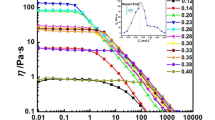Abstract
Rheological measurements were performed to understand the effect of benzyltrimethyl ammonium bromide (BTAB) and NaBr on the growth of wormlike micelles formed by sodium oleate (NaOA). Both salts can make the micellar solution viscoelastic, and the rheological responses verify the formation of wormlike micelles. The viscoelastic solution follows the Maxwell model of a single stress relaxation mode in the low-frequency region. In comparison, the BTAB system exhibits stronger viscoelasticity than the NaBr system at constant salt concentration, but the critical overlapping concentration shows no significant difference; less BTAB can induce the solution to be more viscous than NaBr, but the viscosity maximum of the BTAB system is remarkably lower than that of NaBr at fixed NaOA content. The puzzling result is attributed to the effect of the composition on the packing parameter. In addition, it is shown that the zero-shear viscosity of the two salt systems decreases upon heating, following the Arrhenius mode well.







Similar content being viewed by others
References
Cates ME, Candau SJ (1990) Statics and dynamics of worm-like surfactant micelles. J Phys Condens Matter 2:6869–6892
Kefi S, Lee J, Pope TL, Sullivan P, Nelson E, Hernandez AN, Olsen T, Parlar M, Powers B, Roy A, Wilson A, Twynam A (2004) Oilfield Rev 16:10–23
Watkins C (2009) Chemically enhanced oil recovery stages a comeback. Inform 11:682–685
Dalhaimer P, Engler AJ, Parthasarathy R, Discher DE (2004) Targeted worm micelles. Biomacromolecules 5:1714–1719
Vlachy N, Merle C, Touraud D, Schmidt J, Talmon Y, Heilmann J, Kunz W (2008) Spontaneous formation of bilayers and vesicles in mixtures of single-chain alkyl carboxylates: effect of pH and aging and cytotoxicity studies. Langmuir 24:9983–9988
Acharya DP, Kunieda H (2006) Wormlike micelles in mixed surfactant solution. Adv Colloid Interface Sci 123–126:401–413
Aswal VK (2003) Effect of the hydrophobicity of aromatic counter ions on the structure of ionic micelles. J Phys Chem B 107:13323–13328
Kunieda H, Horii M, Koyama M, Sakamoto K (2001) Solubilization of polar oils in surfactant self-organized structures. J Colloid Interface Sci 236:78–84
Raghavan SR, Kaler EW (2001) Highly viscoelastic wormlike micellar solutions formed by cationic surfactants with long unsaturated tails. Langmuir 17:300–306
Kalur GC, Raghavan SR (2005) Anionic wormlike micellar fluids that display cloud points: rheology and phase behavior. J Phys Chem B 109:8599–8604
Benrraou M, Bales BL, Zana R (2003) Effect of the nature of the counterion on the properties of anionic surfactants. 1. cmc, ionization degree at the cmc and aggregation number of micelles of sodium, cesium, tetramethylammonium, tetraethylammonium, tetrapropylammonium, and tetrabutylammonium dodecyl sulfates. J Phys Chem B 107:13432–13440
Han Y, Feng Y, Sun H, Li Z, Han Y, Wang H (2011) Wormlike micelles formed by sodium erucate in the presence of a tetraalkylammoniumhydrotrope. J Phys Chem B 115:6893–6902
Nakamura K, Shikata T (2006) Threadlike micelle formation of anionic surfactants in aqueous solution. Langmuir 22:9853–9859
Bautista F, Soltero JFA, Macías ER, Puig JE (2002) Irreversible thermodynamics approach and modeling of shear-banding flow of wormlike micelles. J Phys Chem B 106:13018–13026
Granek R, Cates ME (1992) Stress relaxation in living polymers: results from a Poisson renewal model. J Chem Phys 96:4758–4767
Cates ME (1987) Reptation of living polymers: dynamics of entangled polymers in the presence of reversible chain-scission reactions. Macromolecules 20:2289–2296
Hassan PA, Yakhmi JV (2000) Growth of cationic micelles in the presence of organic additives. Langmuir 16:7187–7191
Hassan PA, Candau SJ, Kern F et al (1998) Rheology of worms with varying hydrophobicity of the counterion. Langmuir 14:6025–6029
Candau SJ, Khatory A, Lequeux F, Kern F (1993) Rheological behaviour of wormlike micelles-effect of salt content. J Phys IV 3:197–209
Oelschlaeger C, Suwita P, Willenbacher N (2010) Effect of counterion binding efficiency on structure and dynamics of wormlike micelles. Langmuir 26:7045–7053
Narayanan J, Manohar C, Kern F, Lequeux F, Candau SJ (1997) Linear viscoelasticity of wormlike micellar solutions found in the vicinity of a vesicle–micelle transition. Langmuir 13:5235–5243
Croce V, Cosgrove T, Maitland G, Hughes T, Karlsson G (2003) Rheology, cryogenic transmission electron spectroscopy and small-angle neutron scattering of highly viscoelastic wormlike micellar solutions. Langmuir 19:8536–8541
Fischer P, Rehage H (1997) Rheological master curves of viscoelastic surfactant solutions by varying the solvent viscosity and temperature. Langmuir 13:7012–7020
Ziserman L, Abezgauz L, Ramon O, Raghavan SR, Danino D (2009) Imperfect dissolution in nonionic block copolymer and surfactant mixtures. Langmuir 25:10483–10489
Israelachvili JN, Mitchell DJ, Ninham BW (1976) Theory of self-assembly of hydrocarbon amphiphiles into micelles and bilayers. J Chem Soc, Faraday Trans 2(72):1525–1568
Tung S, Huang Y, Raghavan SR (2007) Contrasting effects of temperature on the rheology of normal and reverse wormlike micelles. Langmuir 23:372–376
Acknowledgments
This work was carried out with the financial support of grants from the National Natural Science Foundation of China and CAAC (No. 60939001 and No. 60979020).
Author information
Authors and Affiliations
Corresponding author
About this article
Cite this article
Han, Y., Wei, Y., Wang, H. et al. Contrasting the Effects of Hydrophobicity and Counterion Size on Anionic Wormlike Micelle Growth. J Surfact Deterg 16, 139–145 (2013). https://doi.org/10.1007/s11743-012-1364-x
Received:
Accepted:
Published:
Issue Date:
DOI: https://doi.org/10.1007/s11743-012-1364-x




